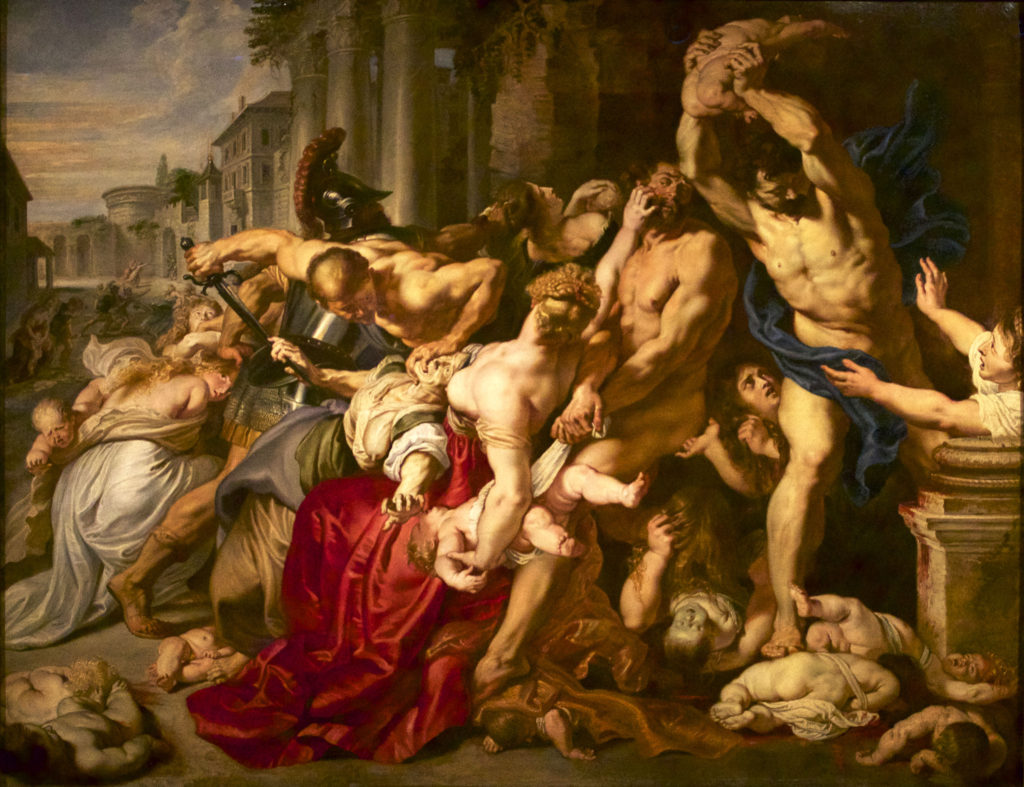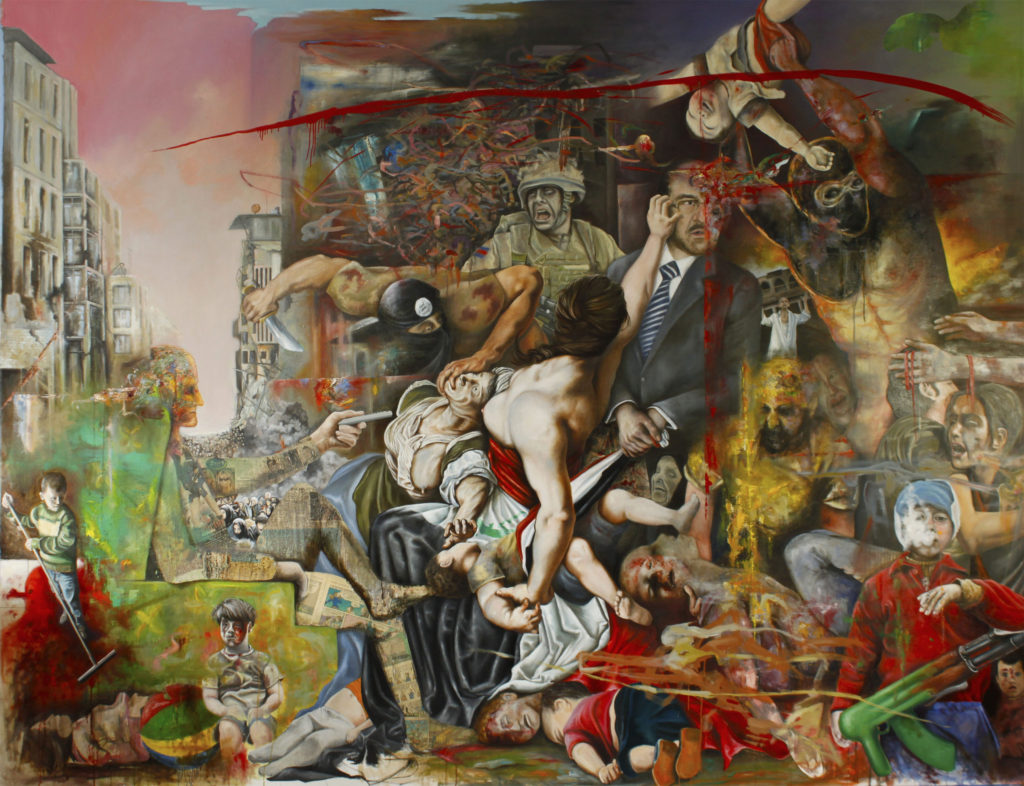special projects
Dego’s Massacre of the Innocents
Introduction by Leonard Beaulne
In the tradition of Western painting, the Massacre of the Innocents has been one of the preferred themes of artists to depict the brutality of war and savagery in humankind. Not surprisingly, painters were drawn to it at times of rising conflict and violence, and their dreadful impact on vulnerable populations. This was particularly the case among masters of the 16th and 17th centuries in Europe, like Rubens, whose art flourished when the new modern age was emerging. With this subject matter they could display the power of their artistic innovations while simultaneously condemning indirectly the barbarism and depravity of their time. They worked, for such a purpose, on developing a visual system of representation which focused on movement, action, dynamics, sharp contrasts and tension. Rubens is considered to have brought this system to its highest degree. When looking at his Massacre of the Innocents, one is struck by the dark energy pulsating throughout the scene, the realism in the portrayal of the human bodies, some of them quasi sculpture-like, reflecting his intention of provoking strong emotions of awe, fear, horror and sadness.
surprisingly, painters were drawn to it at times of rising conflict and violence, and their dreadful impact on vulnerable populations. This was particularly the case among masters of the 16th and 17th centuries in Europe, like Rubens, whose art flourished when the new modern age was emerging. With this subject matter they could display the power of their artistic innovations while simultaneously condemning indirectly the barbarism and depravity of their time. They worked, for such a purpose, on developing a visual system of representation which focused on movement, action, dynamics, sharp contrasts and tension. Rubens is considered to have brought this system to its highest degree. When looking at his Massacre of the Innocents, one is struck by the dark energy pulsating throughout the scene, the realism in the portrayal of the human bodies, some of them quasi sculpture-like, reflecting his intention of provoking strong emotions of awe, fear, horror and sadness.
In presenting his Massacre of the Innocents, Detlef Gotzens (Dego) is taking upon himself a challenging task that he accomplishes with outstanding success. His work captures with as much vivacity the bewilderment, confusion, repulsion and the sheer frightfulness of victims senselessly slaughtered in our contemporary setting. The challenge faced by a painting intending to render in our context a classical theme with as much impact are various. Dego proposes skilful solutions which make his work a remarkable achievement.
upon himself a challenging task that he accomplishes with outstanding success. His work captures with as much vivacity the bewilderment, confusion, repulsion and the sheer frightfulness of victims senselessly slaughtered in our contemporary setting. The challenge faced by a painting intending to render in our context a classical theme with as much impact are various. Dego proposes skilful solutions which make his work a remarkable achievement.
First, there is the challenge of establishing the relationship with his illustrious predecessor while avoiding the pitfalls of repetition, pastiche or kitsch. While the theme remains the same and the intention similar, Dego has to forge a pictorial language that is attuned to the expectations of a different audience. Rubens could rely on the biblical narrative as an external foil to give unity and coherence to his work. The credibility of the narrative was undoubted among his contemporaries and supported the acceptability of his painting. Within that given framework he could deploy all the resources of his talent and the innovations of baroque art to achieve a maximum impact.
For Dego, the situation is different. While he maintains some of the structural elements of the Rubens composition, notably the central compact mass of twisting and buckling human bodies where the tragedy unfolds, he has to reconstruct within the painting itself the context which will give meaning to the scene. The off-balance masses of Rubens and their curvilinear interconnectedness are now compressed, truncated and set in a mostly vertically segmented plane. Some of the characters remain well defined with a painterly texture while many others hover above or around with a phantasmagorical presence. Indices pegged to these characters or strewn about the composition, like the child soldier in the foreground holding an ill-defined weapon, provide some clues to what is going on and the agencies at work. The traditional narrative unity of the scene is broken however. The viewing experience is constantly interrupted by the switching and overlapping of segmented planes accentuating the feeling of dissonance and discordance. While some figures are well delineated, giving strength to the image, others have little contour, fusing at times with the background. The illusion of space is very limited as aerial and linear perspectives are barely present.
Perhaps the most striking feature of the painting, at first glance, is the brilliancy, high luminosity and intensity of the colours. Pure colours shape forms, creating an impression of crispness and presence. It is as if figures were seen through high-definition digital media. Through the power of mimetic representation, the overall picture becomes an image of images, sharing with them the capacity to construct a self-referential world whose grammar is provided by their structural juxtaposition. This captures well the basic experience of a contemporary audience whose access to the world is shaped and mediated by the extended network of the media. The illusion thus created is that the world is always ‘in front of us’ and not ‘around us’.
In presenting a reinterpretation of such a seminal work as that of the Rubens painting, Dego is also compelled to meet a second challenge pertaining to the new conditions of visual credibility of painting in the present context. As a minimum, the advent of a modernist sensibility does away with the often criticized ‘theatricality’ or ‘stage-setting’ features of Rubens’ art. Once the ‘stage-setting’ effects of a painting are seen through, the painting loses its capacity to mesmerize and transfix the beholder. The risk of ‘theatricality’ is however always present in any painting, as the fundamental convention of paintings is to be seen by a beholder who always stands ‘in front of it’. Artists employ many strategies to neutralize ‘theatricality’ and thus enhance credibility. In his Massacre of the Innocents, Dego proposes a remarkable solution to increase believability and strengthen the impact of the work. He inserts a beholder within the structure of the painting itself, creating an alter ego to the viewer. This alter ego is fittingly made up of a collage of newsprint. He is as disembodied as can be and seems to exist only to function as a point of view for observing the cascading and ghastly images making up the scene. We are absorbed unwittingly by our identification with this alter ego, while remaining in reality outside of his purview. A space is thus opened allowing for the possibility of self-awareness.
The system of representation that underpins this brilliant work allows us, as the real beholders, to experience the full ambiguity of being mere spectators while at the same time, through the unfolding of the spectacle, to still be deeply moved by the sight of human suffering

